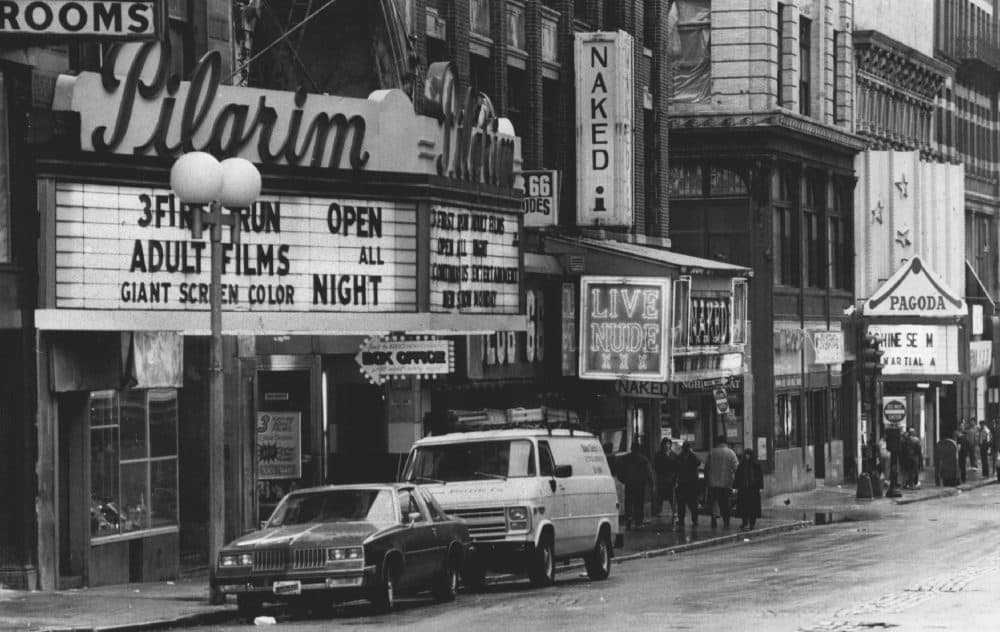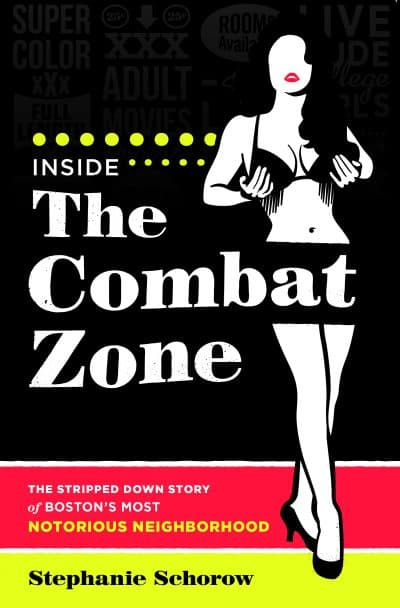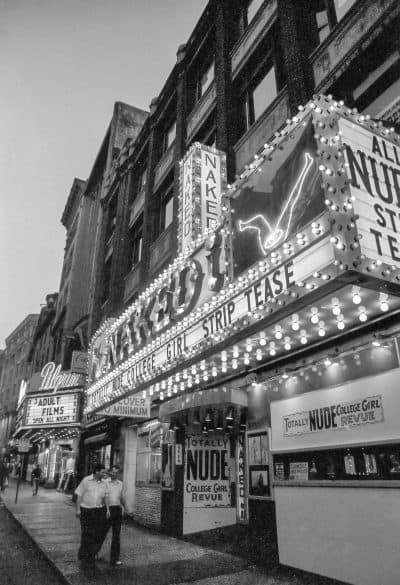Advertisement
From Scollay Square To The Combat Zone, Author Documents Demise Of Boston's Red-Light Scene

“Almost everybody in Boston who was a journalist wrote some story on the Combat Zone,” author and former Boston Herald features writer Stephanie Schorow said in a recent interview.
Actually, she (by her own admission) was probably the only one who didn’t — until now.
With her new book “Inside the Combat Zone: The Stripped Down Story of Boston’s Most Notorious Neighborhood,” Schorow became the first person to write an entire book about Boston’s now-vanished Adult Entertainment District, as it was officially called.
Schorow was born in the Chicago area and raised in Salt Lake City. (“Mitt and I go way back,” she jokes.) She came to Boston in 1989 to work for the Associated Press and later the Boston Herald.
Since her arrival, Schorow — who teaches professional writing at Regis College — has become quite the chronicler of her adopted hometown’s history.
Her previous books include “Drinking Boston: A History of the City and Its Spirits,” “The Cocoanut Grove Fire,” “The Crime of the Century: How the Brink’s Robbers Stole Millions and the Hearts of Boston,” and “The Boston Mob Guide: Hit Men, Hoodlums & Hideouts,” which she co-authored with fellow journalist Beverly Ford.

It is this appreciation for the city’s history that makes Schorow — depending on whom you ask—either “a total bore” or “a real Bostonian.”
Regarding the former, Schorow explained, “I walk through that area [that used to be the Combat Zone] with some of my friends and say, ‘This used to be the Naked i, this used to be the Pilgrim….’ And they’re like, ‘Oh shut up, Stephanie!’”
As for the latter, she said, “I’m focusing on what was there, and someone said, 'That’s what makes you a real Bostonian: when you focus more on what was there than what is there.' ”
This contrast between what was there then and what is now makes for one of the several fascinating takeaways of Schorow’s slender new volume.
In the 1950s, Scollay Square was, as Schorow describes it in the book, “a warren of streets filled with bars, tattoo parlors, and burlesque houses … It was also an entertainment hub, a place for both military men and their dates, men on ‘vacation’ from their wives, thrill-seeking debutants, and teenagers sneaking out for a night on the town.”
Advertisement
This, she writes, “did not fit the vision of a New Boston” that the Boston Redevelopment Authority (now called the Boston Planning & Development Agency) was imagining for the early 1960s.
“Scollay Square died a planned death,” she explained on the phone. “Instead of improving it, they knocked the whole thing down.”
However, this did not completely remove from Boston the less desirable elements of Scollay Square, as urban renewal advocates hoped it would. Instead, it simply moved them elsewhere, specifically, further down the Washington Street thoroughfare and its side streets.
“A bartender would tell the Boston Herald: ‘When they tore down Scollay Square, everybody moved down here’,” Schorow writes. “A Boston Globe writer compared the process to squeezing a balloon at one end: the air just pushes out in a bulge in the other.”
The author emphasizes that the actual businesses themselves did not move to what would be called the Combat Zone. Rather, the types of entertainment previously offered in one spot ended up being available in another. As Schorow writes, “City planners had effectively cut the supply but they could not kill the demand.”
And that demand was clearly more substantial than the city planners fully appreciated.
Compared to the old Scollay Square, Schorow said the Combat Zone “turned out much worse. It was sleazier, it was probably more dangerous, it was more problematic, more raw. Far worse than anything they would have thought about.”
“By early 1970,” according to the book, “there were about thirty-five sex-related businesses, including about twenty-six adult bookstores and nude dancing venues, all concentrated along lower Washington Street and in Park Square [west of Washington Street and just south of Boston Public Garden]. The Combat Zone was becoming a world unto itself, at once sordid and tolerant, a community for those outside of the mainstream.”

Chinatown had the misfortune of abutting this “urban nightmare.” Having more than doubled in population in the 1940s, its landscape was decimated by the building of the Central Artery in the 1950s and an extension of the Massachusetts Turnpike in the 1960s.
Schorow quotes a Chinatown community leader named Frank Chin as having said, “In the early days, the Combat Zone was more or less burlesque. They didn’t have nudity. There were no drugs. Later on, there were drugs and houses of prostitution. It was bad. It hurt the businesses of Chinatown. People didn’t want to go to Chinatown.”
Eventually, Chinatown “found its voice and its power in protesting against the Combat Zone,” Schorow said.
“Now,” she continued, “prices are going up so many of the people there are in danger of being priced out the neighborhood.”
The changes on Washington Street and its adjacent areas are plain for all to see now. Schorow writes about a man whose father owned a pizza shop in the Combat Zone who rues having not invested in property on the streets that he roamed as a teenager. Only two strip clubs remain, and both are on LaGrange Street, which was once ground zero for prostitution.
Finally, Park Square, once home to the Playboy Club, the Mousetrap Lounge and the Teddy Bear Lounge, now boasts the Four Seasons Hotel, the Boston Park Plaza Hotel and Towers and fine dining establishments.
The story of Boston’s transformed topography in the latter half of the 20th century is only one of the valuable aspects of “Inside the Combat Zone.” Schorow also discusses prevailing social, cultural and political trends, the people for whom the area was a daily fact of life, the unfortunate but inevitable criminal activity and the “long, slow death” of the government-sanctioned Adult Entertainment District. The result is a captivating historical account and sociological examination.